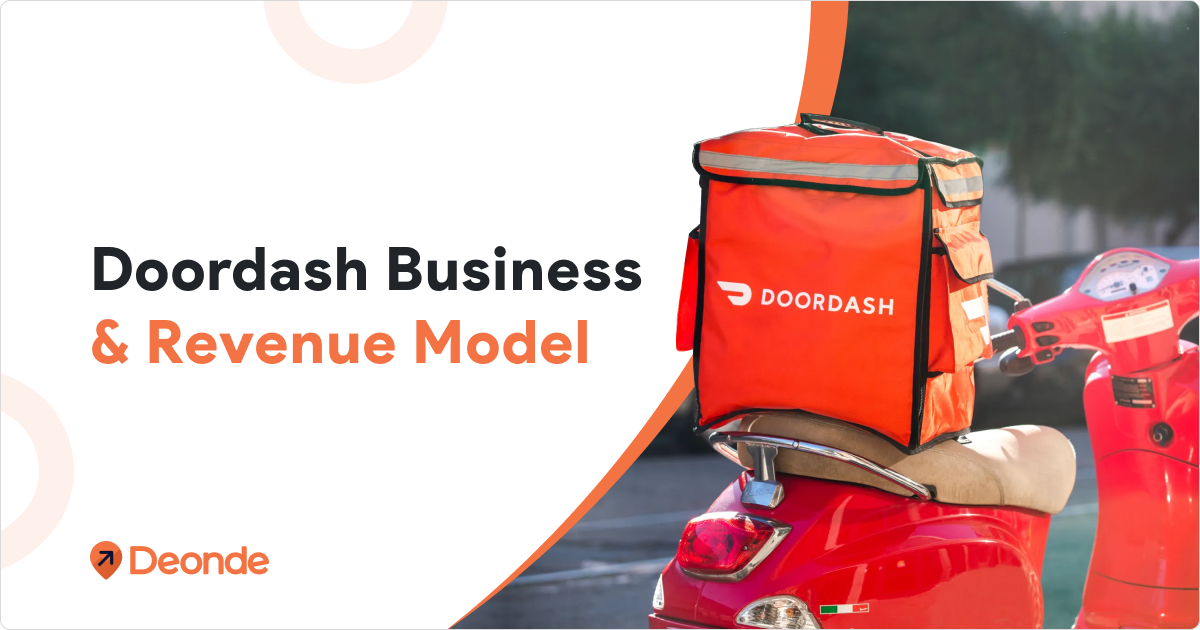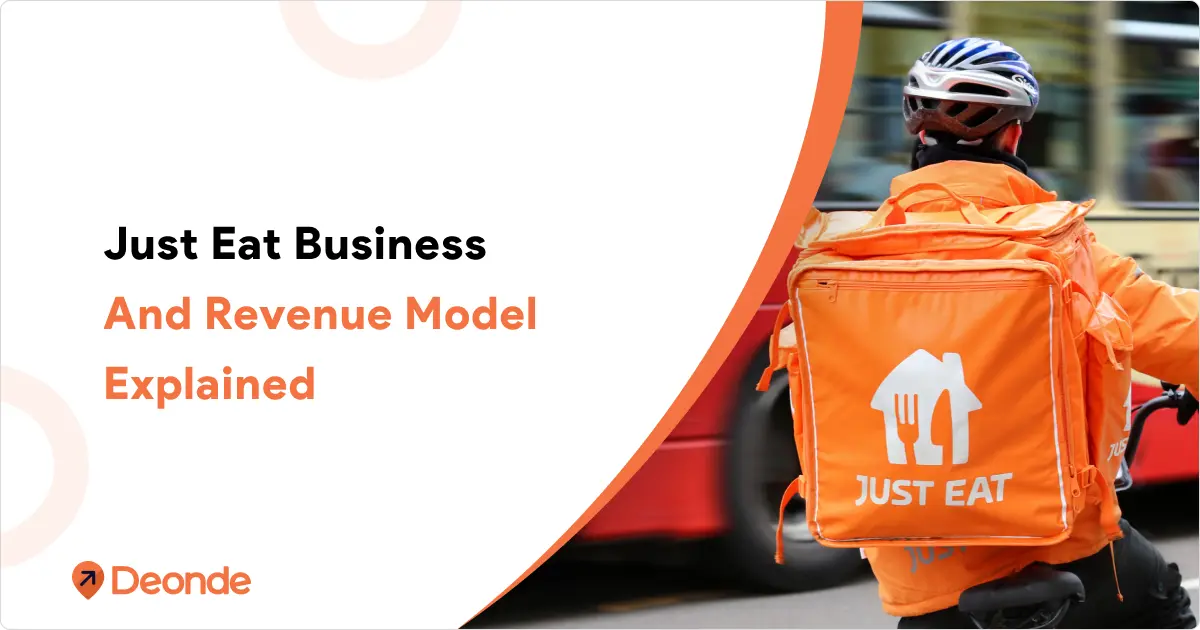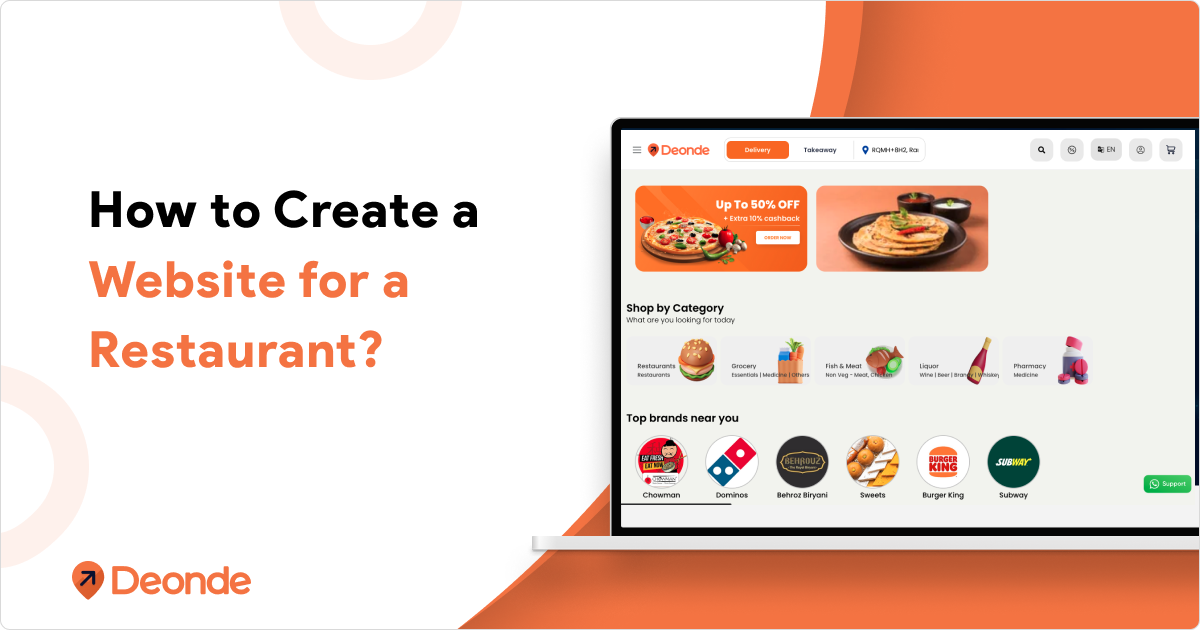On-demand food delivery apps worldwide are seeing a surge in their customer base. In our opinion, unparalleled user convenience coupled with ease of access are responsible for the apps’ beaming popularity.
Thanks to these food delivery mobile apps, with just a few taps, a world of culinary delights is at our fingertips.
The United States, in particular, has emerged as a global leader in food delivery, with billions of dollars flowing through these platforms. Speaking of on-demand food delivery apps in USA, DoorDash is one of the biggest names that comes to mind.
Did you know that DoorDash has a 65% market share in the USA? Further, it also has a gross order volume higher than 53 billion USD.
Did these numbers impress you?
Then it’s time to delve deep into the business and revenue model of DoorDash. In this blog, we’ll talk about DoorDash, how it works, and more importantly, how it generates revenue.
We’ll also guide you with industry tips and tricks in case you want to develop an app like DoorDash.
So, let’s get started!
What is DoorDash?
DoorDash wasn’t born out of thin air.
It was the brainchild of Stanford alumni, Andy Fang, Tony Xu, Evan Moore, and Stanley Tang, who recognized a need to revolutionize the on-demand meal delivery industry.
Back then, food delivery services simply listed restaurants, leaving restaurants to handle deliveries themselves. This model often resulted in delays and inconsistencies.
Determined to create a smoother experience, the founders launched a pilot project called “PaloAltoDelivery.com” in 2013.
Within the first week, the platform received an overwhelming response, processing hundreds of orders daily. This immediate success confirmed their vision, and they soon formalized the platform, christening it DoorDash.
By 2015, just two years after its launch, DoorDash had expanded to 18 cities across the US.
This rapid growth, fueled by a user base hungry for a more convenient delivery experience, propelled DoorDash’s valuation to a staggering $600 million.
How does DoorDash work?
DoorDash operates on a pretty straightforward on-demand food delivery business model that connects online customers with local restaurants and delivery drivers.
Here’s a brief breakdown of how DoorDash works:
Customers Place Orders
DoorDash users login to the DoorDash app or their web ordering page and search for local restaurants. Once they’ve located their favorite hyper-local restaurants, they can browse menus, look at pricing, and also explore offers and discounts.
Once they’ve selected their food items, they can customize orders, add special instructions, and proceed to checkout.
After placing an order, DoorDash users can track its progress in real-time, from restaurant pickup to delivery.
Order Fulfillment
But before restaurant vendors can do that, DoorDash requires its food vendor to come on board. In this phase, the restaurants make their profile, put up menus, and officially declare that they’re open for business.
DoorDash also provides food vendors with tools and resources to manage online orders and facilitate delivery.
When an order is placed, the restaurant receives a notification and prepares the food. The restaurant admins can then track how well their business is doing through data sheets and KPI analysis.
They can also streamline their workflows through real-time inventory management, driver management, and customer servicing.
Delivering orders
DoorDash has an extensive network of delivery partners who work tirelessly to deliver hot steaming food to the user’s doorstep.
DoorDash’s delivery drivers use a dedicated app to accept and complete orders.
Once a delivery partner accepts an order, they pick up the food from the restaurant. Then they deliver it to the customer’s preferred address.
By streamlining this process and leveraging technology, DoorDash ensures a seamless experience for both customers and restaurant partners.
DoorDash’s Business Model: Explained
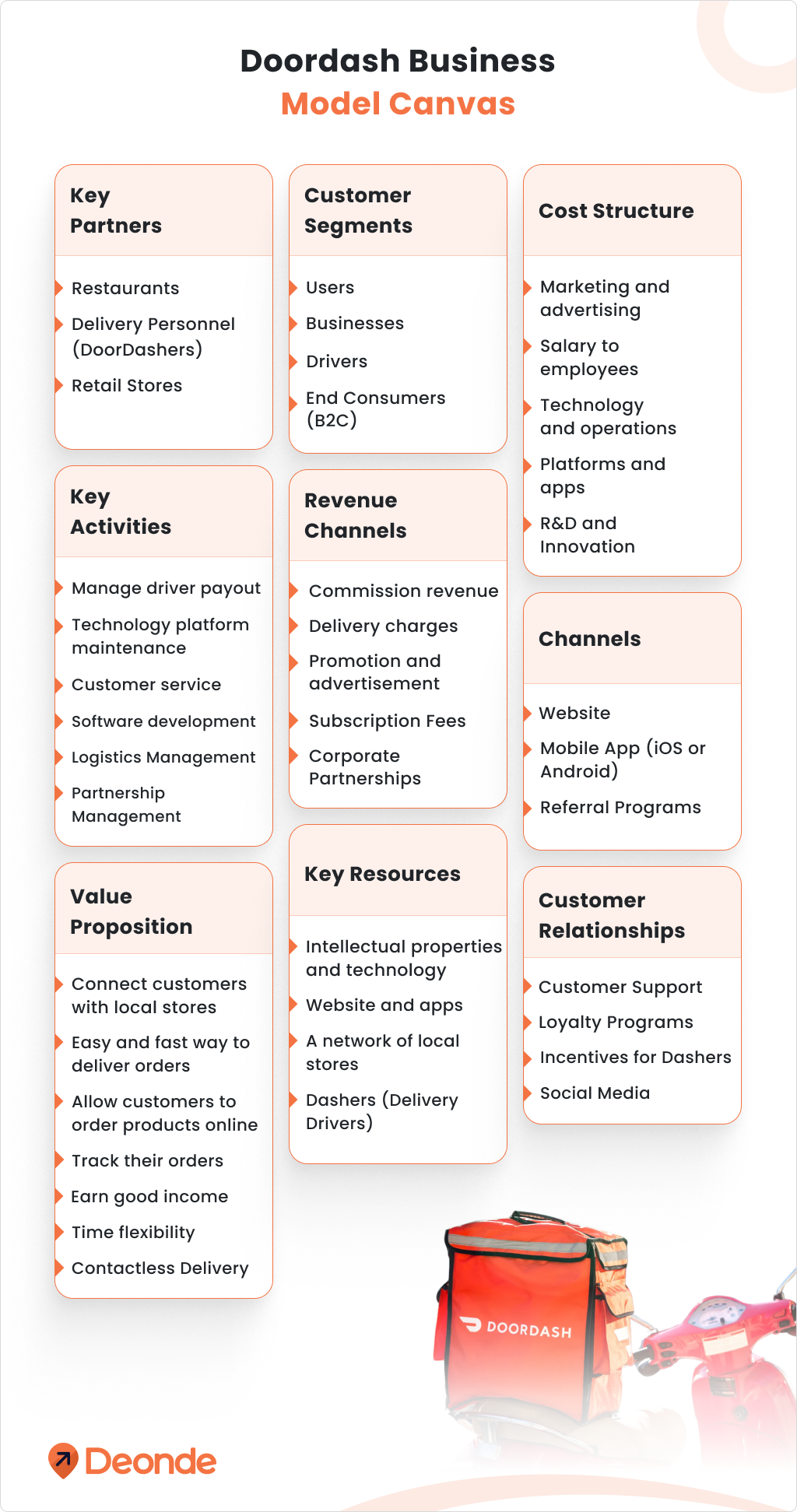
DoorDash is a technology-driven online food delivery company that connects customers with local restaurants and delivery drivers.
It operates through the DoorDash food delivery platform, facilitating delivery services, and allowing customers to order food from their favorite restaurants.
DoorDash’s Value Proposition
For Customers:
DoorDash offers a user-friendly on-demand food ordering app and website for customers to browse menus, place orders, and track deliveries.
The platform provides access to a wide range of restaurants and cuisines. By offering a variety of meals, including vegetarian, non-vegetarian, vegan, and dairy-free options on their platform, DoorDash can cater to a huge chunk of the target market.
DoorDash aims to maximize user convenience by delivering orders promptly. DoorDash leverages a comprehensive network of committed delivery partners and restaurant vendors to make this possible.
DoorDash also uses AI-powered recommendations to tailor and customize the user’s experience.
For Restaurants:
The DoorDash platform essentially functions as an online marketplace for restaurants. Using the app’s popularity, restaurants can expand their customer base and boost sales.
The DoorDash platform also helps partner restaurants streamline their workflows by supplementing them with tools to manage orders and delivery processes.
Restaurants partnered with DoorDash also have access to valuable insights into customer preferences, ordering behavior, online sales, and market reach.
For Delivery Drivers:
DoorDash empowers delivery drivers by allowing them to work on the go. Drivers can choose their own hours and work independently.
DoorDash drivers earn competitive wages and have an opportunity to pocket 100% of the tips they receive.
Lastly, DoorDash also provides support and insurance benefits to its delivery drivers.
Key Business Partnerships
The success of DoorDash’s business model hinges on strategic partnerships with various stakeholders.
Here’s a breakdown of its key business partnerships:
Restaurant Vendors:
DoorDash partners with a wide range of restaurants, from local eateries to national chains to offer a variety of eateries on their platform. Doing so helps DoorDash cater to a vast audience and boost total sales.
This partnership with DoorDash enables restaurants to reach a larger customer base and increase their overall revenue. They can also boost their bottom line by promoting their restaurant on the DoorDash app. This way, restaurants can build a base of loyal customers without affecting their walk-ins.
Restaurants onboarding with DoorDash can get their hands on valuable data and analytics, further helping them understand customer preferences. Having access to crucial KPIs can help restaurants improve their menus, taste, and even customer service.
Delivery Drivers:
DoorDash’s delivery network is the backbone of its operations.
It relies heavily on a vast network of independent contractors, commonly known as Dashers, to pick up orders from restaurants and deliver them to customers’ doorsteps.
Dashers play a crucial role in fulfilling customer orders. They pick up orders from restaurants and deliver them to customers’ addresses on time.
The quality of food delivered directly affects customer satisfaction. Dashers are responsible for ensuring that orders are delivered on time, in good condition, and with excellent customer service.
DoorDash’s app allows customers to track their orders in real-time, thanks to the efforts of delivery drivers who update their location and status.
During peak hours or special events, the delivery network ensures efficient order fulfillment by increasing the number of active Dashers.
Third-Party Technology Providers:
DoorDash collaborates with technology providers to improve its platform’s performance, scalability, and security.
Such third-party apps enhance the functioning of the DoorDash food ordering app and also enable it to leverage data analytics for optimized operations.
A smooth-functioning app enhances the customer experience and incentivizes users to order from DoorDash time again.
DoorDash also partners with payment processors to ensure secure and efficient transactions.
By fostering strong partnerships with these key stakeholders, DoorDash can continue to innovate, expand its market reach, and deliver a superior customer experience.
DoorDash Revenue Model: How DoorDash Makes Money?
So far, we’ve seen how DoorDash strategically partners with restaurant vendors, drivers, and tech service providers to keep the business running.
However, before we understand why this business model is so successful, we need to comprehend DoorDash’s revenue strategy.
In simpler words, this is how DoorDash brings money to the table:
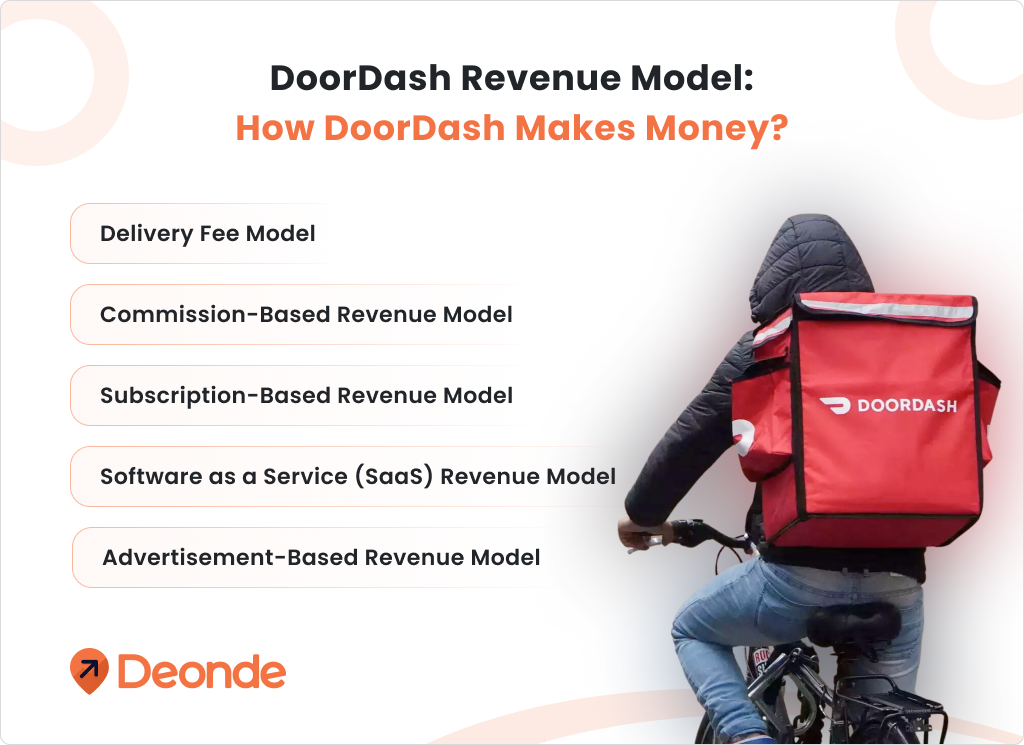
Delivery Fee Model
One of DoorDash’s main sources of revenue is its delivery fee model.
With its capability to retain users, DoorDash heavily relies on it.
The user is charged a delivery fee based on the distance between the pickup and the drop-off location. DoorDash may charge a surge delivery fee during rush hours.
1. Commission-Based Revenue Model
For every successful order made via its platform, DoorDash earns a variable commission from the restaurants. The commission is typically 20% of the order total but can be higher or lower depending on the restaurant. For example, if a customer orders a $100 meal, DoorDash would keep $20 as a commission.
DoorDash has a tiered commission structure, as it offers three different plans for restaurants to choose from ranging from Basic, Plus, and Premier.
DoorDash charges restaurants a commission fee based on the total order value. This fee structure incentivizes restaurants to maintain high-quality service and customer satisfaction, as it directly impacts their revenue on the DoorDash platform.
2. Subscription-Based Revenue Model
DoorDash also has a subscription service called DashPass for customers to save on delivery and service fees.
This model generates revenue by charging the users a recurring fee that is processed at regular intervals.
DashPass benefits apply to eligible orders from participating restaurants that meet a minimum order subtotal. The specific minimum subtotal may vary by restaurant.
DashPass is currently available in select areas within the United States and Canada.
3. Software as a Service (SaaS) Revenue Model
DoorDash has a SaaS revenue model in the form of a DoorDash storefront for restaurants.
The software helps restaurants to set up their own online ordering system and take control of the online delivery and pickup orders.
4. Advertisement-Based Revenue Model
DoorDash generates revenue not only from delivery fees and commissions but also through advertising.
Restaurants can promote their menus and specials on the platform by paying advertising fees.
Restaurant Vendors can purchase advertisement space to highlight their promotions, new menu items, or special offers. By charging for these advertising slots, DoorDash increases its revenue stream.
What Makes DoorDash Business Model Successful?
One of the main reasons behind the success of DoorDash is its aim to provide customer satisfaction.
Today, the DoorDash business model is a part of the growth strategy of numerous service industries that drive an on-demand economy through constant funding.
But what are some of the factors that make DoorDash’s business model successful?
Check below:
- DoorDash business model is constantly evolving and expanding. DoorDash keeps adding new services, which further allows the company to attract new customers while retaining the existing ones.
- Another reason that makes the on-demand food delivery app so successful is its extremely convenient services to the users. DoorDash’s delivery fees are typically lower than the cost of traveling to the restaurant or paying for parking. Customers can also save money by using DoorDash’s promotions and discounts.
- DoorDash has also utilized the power of social media platforms such as Twitter, Facebook, and other marketing techniques, to promote its food ordering app.
- Another factor that makes DoorDash’s business model successful is its services to facilitate customer support via different modes, such as email, mobile app feedback page, etc.
Conclusion: Build on DoorDash’s Winning Strategy
DoorDash has revolutionized food delivery by creating a sophisticated ecosystem that connects restaurants, consumers, and delivery drivers.
Its multi-faceted platform generates revenue through strategic fees, commissions, and service charges, transforming a simple delivery service into a complex, value-driven business model.
The company’s success lies in its ability to solve marketplace challenges, offering mutual benefits to all stakeholders. By leveraging technology and data-driven insights, DoorDash continues to adapt and grow in the competitive food delivery landscape.
As the market evolves, DoorDash’s innovative approach and flexible business model position it to remain a leader in digital food delivery services.
Do you Want to Build an App just Like DoorDash?
Isn’t the story of the DoorDash business model a lesson for entrepreneurs, startups, and small businesses who are either in the food industry or want to start their own businesses?
If you’re in the business of food delivery, you may have the question, “How to create an app like DoorDash?”
To build an on-demand food delivery app like DoorDash, you need the help of professionals in this industry. Deonde is a pioneering food delivery app development company where we can help you with flexible app development solutions.
Our ready-made white-labeled SaaS-based solutions will help you launch your food delivery business in just 7 days.
With DoorDash clone, you can design and build a food delivery app solution with all the customizations that you need as per your business requirements.
Why Choose Deonde?
Rapid Deployment: Our pre-built, white-label solutions allow you to launch your app in a matter of days.
Customizable Solutions: Tailor your app to your specific business needs and brand identity.
Expert Development Team: Our skilled developers create robust and scalable apps.
Seamless Integration: Integrate with payment gateways, logistics providers, and restaurant partners.
Ongoing Support: Benefit from our post-launch support and maintenance services.
Key Features of Deonde’s DoorDash-like App:
- User-Friendly App: Intuitive customer-facing online ordering interface that simplifies ordering and tracking.
- Real-time Tracking: Using this, customers can monitor order status and delivery progress.
- Multiple Payment Options: Offer various payment methods for user convenience.
- Push Notifications: Keeping customers informed about order updates and promotions through personalized push notifications.
- Loyalty Programs: Build a troop of loyal customers and reward them with points and discounts.
- Robust Admin Panel: Using this, restaurant vendors can manage orders, drivers, and restaurant partners efficiently.
Let’s Bring Your Food Delivery App to Life
Ready to disrupt the food delivery market?
Contact Deonde today to discuss your project and explore how we can help you build a successful food delivery app.
FAQs:
1. What is the DoorDash script?
The DoorDash script refers to the proprietary software platform that powers the company’s entire food delivery system.
This sophisticated technology enables seamless interactions between restaurants, customers, and delivery drivers, managing everything from order placement and routing to payment processing and real-time tracking.
The script integrates complex algorithms that optimize delivery routes, estimate delivery times, and ensure efficient matching between available drivers and restaurant orders.
2. What is a DashPass? How does it contribute to DoorDash’s revenue?
DashPass is a subscription service offered by DoorDash that provides customers with unlimited free delivery and reduced service fees for a monthly or annual fee.
By charging a recurring subscription, DoorDash creates a steady revenue stream while incentivizing customer loyalty and increasing order frequency.
Subscribers benefit from cost savings on delivery fees, which encourages more frequent platform usage and helps DoorDash generate consistent monthly income beyond traditional transaction-based revenues.
3. Does DoorDash have other services beyond on-demand food delivery?
DoorDash has significantly expanded its service offerings beyond restaurant food delivery.
The company now provides grocery delivery through partnerships with major supermarket chains, convenience store item delivery, and even non-food item delivery from various retail stores.
Additionally, DoorDash has launched DoorDash Drive, a B2B logistics service that allows businesses to utilize their delivery network to transport non-restaurant items, further diversifying their revenue streams and marketplace capabilities.
4. Can I create an app like DoorDash at an affordable price?
Leverage the expertise of Deonde—a ready-made food delivery app suite. Deonde offers pre-built, customizable food delivery app solutions that can significantly reduce development time and cost. By leveraging their expertise and technology, you can launch your own food delivery app without starting from scratch.

